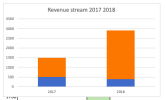I'm a veteran Excel user but I hardly ever touch charts and I have a question which I suspect may have a simple solution, but I've not found one whilst trawling the internet.
Making up a scenario, I have a table that contains the following data:
- Columns: Years
- Rows: Revenue streams (two types only)
- Values: Revenue generated
I want a stacked bar chart that shows the year along the x-axis and the values on the y-axis. However, I want the bars to be stacked according to the following logic:
1 - The revenue stream generating the least amount of revenue in the year is shown at the bottom of the bar/column i.e. the first component rising from the x-axis
2 - The revenue stream generating the most amount of revenue in the year is stacked on top of the first revenue stream and;
3 - With reference to the y-axis, the top of the bar/column stops at the point that represents the total revenue for the year
For example:
- in 2017 revenue stream 1 generated $500. Revenue stream 2 generated $1,000. Total revenue therefore $1,500. Revenue stream 1 begins from the x-axis and rises to $500 on the y-axis. Revenue stream 2 commences from the top of revenue stream 1 i.e. at $500 on the y-axis, and continues up to the point of $1,500 on the y-axis
- in 2018 revenue stream 1 generated $2,500 whilst revenue stream 2 generated only $400. Total revenue therefore $2,900. As revenue stream 2 generated the least amount of income in this year, it is the first component of the bar/column. Revenue stream 2 therefore begins from the x-axis and rises to $400 on the y-axis. Revenue stream 1 commences from the top of revenue stream 1 i.e. at $400 on the y-axis, and continues up to the point of $2,900 on the y-axis
I'm using a stacked bar chart at present which complies with points 1 & 3 above, but as for point 2, the components (revenue streams) do not change according to year. Is there something I need to change under the 'Select Data' option of the series?
Making up a scenario, I have a table that contains the following data:
- Columns: Years
- Rows: Revenue streams (two types only)
- Values: Revenue generated
I want a stacked bar chart that shows the year along the x-axis and the values on the y-axis. However, I want the bars to be stacked according to the following logic:
1 - The revenue stream generating the least amount of revenue in the year is shown at the bottom of the bar/column i.e. the first component rising from the x-axis
2 - The revenue stream generating the most amount of revenue in the year is stacked on top of the first revenue stream and;
3 - With reference to the y-axis, the top of the bar/column stops at the point that represents the total revenue for the year
For example:
- in 2017 revenue stream 1 generated $500. Revenue stream 2 generated $1,000. Total revenue therefore $1,500. Revenue stream 1 begins from the x-axis and rises to $500 on the y-axis. Revenue stream 2 commences from the top of revenue stream 1 i.e. at $500 on the y-axis, and continues up to the point of $1,500 on the y-axis
- in 2018 revenue stream 1 generated $2,500 whilst revenue stream 2 generated only $400. Total revenue therefore $2,900. As revenue stream 2 generated the least amount of income in this year, it is the first component of the bar/column. Revenue stream 2 therefore begins from the x-axis and rises to $400 on the y-axis. Revenue stream 1 commences from the top of revenue stream 1 i.e. at $400 on the y-axis, and continues up to the point of $2,900 on the y-axis
I'm using a stacked bar chart at present which complies with points 1 & 3 above, but as for point 2, the components (revenue streams) do not change according to year. Is there something I need to change under the 'Select Data' option of the series?
Last edited:


